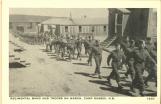11
Soldiers on Parade Accompanied by their Marching Band1939-1945
Sussex, New Brunswick, Canada
 Credits:
Credits:Kings County Historical Society
General Orders
12
During the early years of the war, a number of divisions moved through the camp, including the 3rd, 4th and 7th Divisions. Units in these divisions came from all points across Canada. It is not the intent of the writer to provide histories of these units but use the information provided to illustrate the capacity and the capability of the camp to train soldiers for eventual combat on the European battlefields of WW II. One also had to recognize the impact that this number of soldiers would have on the local economy, and the changes it would impose on the lifestyle of a predominantly rural community. Numbers this large were not seen at the camp in World War I or at any previous time in history.Some of the first units into the camp were the New Brunswick units such as the NB Rangers, the North Shore Regiment and the Carlton York Regiment. As we recall earlier histroy of the camp, these units were the present day descendants of the 67th, 71st, 73rd and 74th Battalions of the late 1800's and early 1900's. Again the war effort looked to be a primarily infantry battle and the first divisions to go overseas were primarily infantry with related support elements. This let to many of the other arms such as the Hussars watching their units bled of men as the volunteers could not wait for their own unit to be called up. Even the NB Rangers were not immune and many of their members requested transfers when it was determined that the Rangers were to be used for coastal security duties in such areas as Sydney, NS and Goose Bay, Labrador.
However unlike the First World War, units were to retain their unit names and the use of numbered battalions was discontinued. And it was soon recognized that there was a need for armour reigiments and the Hussars found themselves first as a motorcycle regiment and soon after as an armoured unit in which role they were to continue during the war and even up until the present.
The camp was rudimentry at best at the onset and most units found themselves in possession of H huts which were primary open shells with wash room facilities in the center of the H. Each unit initially had the responsibility of building the interior to meet the needs of the unit and the many carpenters enlisted these units rose to the task. The North Shore Battalion history describes the camp when they moved in on 05 Dec 1940; " off in the distance stretched rows and rows of army huts, wearing their cap of winter white". "We marched up through town struggling under the loads of our packs which carried everything but the kitchen sinks". Training was not confined to the camp and the diary goes on to say, "Sussex has its hills and I am sure we missed none of them". By mid March 1941, the camp was a soupy mess of red mud and Bren Gun Carriers had just arrived which the men delighted in driving through the mud.
As the above mentioned units moved through the camp, and the build up of the necessary units were established overseas in the United Kingdom, the focus of the camp was to change for the duration of the war.